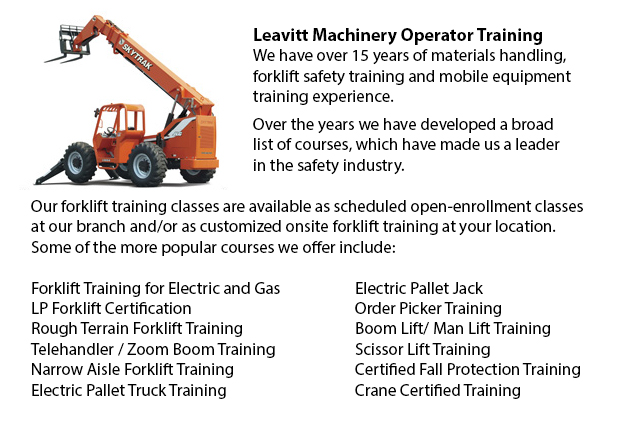
Mississauga Telehandler License - A telescopic handler or telehandler is an equipment that is generally used in industrial and agricultural applications. It has a similar appearance to a forklift and even functions in a similar way, although, the telehandler is more of a crane than a lift truck. It has a telescopic boom which can extend upward and forwards from the motor vehicle. The boom has the capability to fit one of several accessories like for instance muck grab, pallet forks, a bucket or a lift table.
The most common telehandler attachments are pallet forks. The telehandler is used to transfer merchandise in sites where the loads cannot be moved by a typical forklift. Telehandlers are particularly useful for placing loads on rooftops for instance, or for removing palletized cargo from with a trailer. Many of the tasks that a telehandler can accomplish will otherwise need a crane and this particular piece of equipment can be costly, not always time efficient and not practical.
The boom acts as a lever, raising and extending while bearing a load. Although there are back counterweights, this can cause the telehandler to become more unbalanced. Thus, the greatest advantage of the telehandler is likewise its greatest limitation. As the working radius increases, the lifting capacity decreases. The working radius is defined as the distance between the center of the load and the front of the wheels.
Like for instance, a telehandler with a 5000 lb capability with the boom retracted could safely lift as little as 400 lb as soon as it is completely extended at a low boom angle. The equivalent machine which has a 5000 lb lift capacity and the boom retracted can support up to 10,000 lb with the boom raised to 70 degrees. The operator has a load chart to help determine whether a specific lifting job could be done in a safe and efficient manner. This particular chart takes into consideration the boom angle, the weight and height.
To be able to monitor the telehandler, they come equipped with a computer which utilizes sensors. These sensors work to warn the operator, with some being able to cut controls to certain inputs if the limits of the motor vehicle are exceeded. Several telehandler types are likewise outfitted along with front outriggers which are known as mobile cranes. These greatly extend the lifting capacity of the equipment while it is stationary.
-
Mississauga Crane Training Courses
Mississauga Crane Training Courses - The heavy equipment crane is intended to move, lift and lower heavy stuff. Normally, the crane comes outfitted along with a hoist, sheaves, and chains or wire ropes. Cranes are utilized in the manufacturing, const... More -
Mississauga Telehandler Ticket
Mississauga Telehandler Ticket - The telescopic handler or telehandler is a normally utilized machine in agricultural and industrial applications. This machine is the same in look to a forklift and even works in a similar way, even though telehandler... More -
Mississauga Overhead Crane Ticket
Mississauga Overhead Crane Ticket - An overhead crane is normally used in industrial environments. Likewise referred to as a bridge crane, this equipment includes parallel runways spanned by a traveling bridge. The component that lifts materials is t... More -
Mississauga Forklift Safety Training
Mississauga Forklift Safety Training - Any person who wants to operate a lift truck has to take a forklift safety training program in order to become a certified forklift truck operator. There are various ways to acquire forklift training. Courses ar... More -
Mississauga Heavy Equipment Training
Mississauga Heavy Equipment Training - Normally, the different kinds of heavy equipment training are divided into 2 categories of equipment: those that have rubber tires and tracked vehicles. Tracked vehicles include items such as excavators, cranes,... More -
Mississauga Loader Ticket
Mississauga Loader Ticket - Loaders have been created to operate practically anywhere. They offer optimal traction and maneuverability because of a heavy-duty oscillating joint which offers 45-degree rotating angles toward the left and right, with 10... More -
Mississauga Boom Lift Certification
Mississauga Boom Lift Certification - Elevated work platforms allow maintenance operations and work to be done at levels which can not be reached by whichever other means. Boom Lift Certification Training educates workers about safely operating boom... More -
Mississauga Forklift Training School
Mississauga Forklift Training School - Why A Forklift Operator Must Take A Forklift Training School - Federal and industry regulators have established the criteria for forklift safety training based on their existing standards and regulations. People... More

Forklift Certification Mississauga
TOLL FREE: 1-888-254-6157
Mississauga, Ontario
forkliftcertificationmississauga.com
Email Us
About Us


